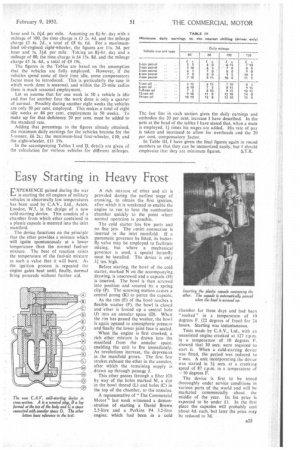Easy Starting in Heavy Frost
Page 61

If you've noticed an error in this article please click here to report it so we can fix it.
EXPER1ENCE gained during the war LA in starting the oil engines of military vehicles in abnormally low temperatures has been used by C.A.V., Ltd., Acton, London, W.3, in the design of a new cold-starting device. This consists of a chamber from which ether contained in a plastic capsule is metered into the inlet manifold.
The device functions on the principle that the ether provides a mixture which will ignite spontaneously at a lower temperature than the normal fuel-air mixture. The heat of reaction raises the temperature of the fuel-air mixture to such a value that it will burn. As the ignition process is repeated the engine gains heat until, finally, normal firing proceeds without further aid.
A rich mixture of ether and air is provided during the earliest stage of cranking, to obtain the first ignition, after which it is weakened to enable the engine to run to heat the combustion chamber quickly to the point where normal operation is possible.
The cold starter has few parts and no fine jets. The outlet connection is inserted in the inlet manifold. If a pneumatic governor be fitted, its butterfly valve may be employed to facilitate mixing, but where a mechanical governor is used, a special butterfly must be installed. The device is only
ins, high.
Before starting, the bowl of the cold starter, marked N on the accompanying drawing, is unscrewed and a capsule (H) is inserted. The bowl is then screwed into position and secured by a spring clip (P). The screwing motion causes a central prong (K) to pierce the capsule.
As the rim (E) of the bowl reaches a flexible washer (F), the bowl is closed and ether is forced up a central hole (J) into an annular space (D). When the rim has passed the washer, the bowl is again opened to atmospheric pressure and finally the lower joint face is sealed.
When the engine is first cranked, a rich ether mixture is drawn into the manifold from the annular space, enabling the unit to fire immediately. As revolutions increase, the depression in the manifold grows. The first few strokes exhaust the ether in the annulus, after which the remaining supply is drawn up-through passage J.
This ether passes through a filter (0) by way of the holes marked M, a slot in the bowl thread (L) and holes (C) in the top of the chamber, to the annulus. A representative of "The Commercial Motors' last week witnessed a demonstration of starting a David Brown 2.5-litre and a Perkins P4 3.2-litre engine, Which had been in a cold
chamber for three days and had been "soaked" in a temperature of 10 degrees F. (22 degrees of frost) for 24 hours. Starting was instantaneous.
Tests made by C.A.V., Ltd., with an unassisted engine cranked at 127 r.p.m. in a temperature of 10 degrees F. showed that 30 secs, were required to start it. When a cold-starting device was fitted, the period was reduced to 2 secs. A unit incorporating the device was started in 33 secs. at a cranking speed of 87 r.p.m. in a temperature of —10 degrees F.
The device is first to be tested thoroughly under service conditions in various parts of the world and will be marketed commercially about the middle of the year. Its list price is expected to be under £1. In the first place the capsules will probably cost about 4d. each. but later the price inay be reduced to 3d.




























































































